Habitat mosaic: Finding Toronto’s wild side
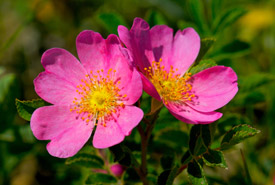
Prairie rose (Photo by Karol Dabbs)
“The spring has sprung, the grass is rizz. I wonder where them birdies is?” ~ Winnie the Pooh
Of course spring is just around the bend (officially one day away, if you’re counting) and with it, the city’s fauna will blossom before our eyes, just as the flora does.
The first item that comes to mind as seasons change is where to observe the renewed bounty of wildlife in the city. Observing wildlife and their habitats from a safe distance is an extraordinary pleasure. The examples below show where you can track a few of our cities’ impressive permanent (all-season) residents. I’ve included some winter habitat details as well because many of us still have half a foot of snow or more. The list below only features mammal, bird and fish species because reptiles, amphibians and insects are mostly inactive during the winter.
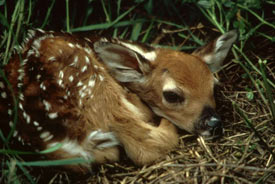
White-tailed deer fawn (Photo by USFWS)
White-tailed deer
Habitat — In winter, conifer stands provide warmth and shallow snow for sleep and cover; brush and twigs provide feed. Look for full-body impressions in snow, dense brush and tall foliage. Fawns hide out in thick brush for several weeks in spring. In summer, deer are known to travel as central as mid-town backyard gardens.
My recent sightings — Near Toronto's Humber Arboretum, the woodlands behind Sunnybrook Hospital and Glendon College, the Don Valley, Toronto Island and Tommy Thompson Park.
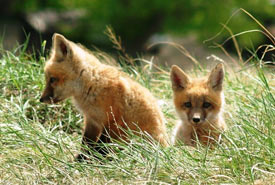
Red fox kits (Photo by NCC)
Red fox
Habitat — Adult fox pairs come back together in the late winter and early spring to mate and den. In fall and winter they find shelter in thickets. After breeding, they use burrows, hollow logs, and thickets to den with kits in knolls in fields, stream banks, hedge and fence rows and forest edges.
In spring and summer they are often spotted on golf courses. Ravines and utility corridors are used for extensive travel through all seasons.
My recent sightings — In Toronto's Mt. Pleasant Cemetery, Rouge Park, Humber Valley meadows, Crothers Woods.
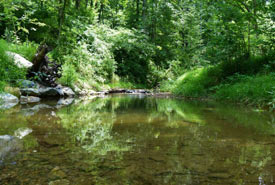
Stream in the forest (Photo by Tim Emrich - Public Domain Pictures)
Mottled sculpin
Habitat — Prefer cold, clear water streams and Lake Ontario’s rocky shores. Typically a benthic species, in streams it can be spotted on gravel riffles (shallow, turbulent water over gravel). Sensitive to pollution and water temperature increases, they are considered an indicator species for health of a watershed.
My recent sightings — At Toronto's Duffins Creek, Lake Ontario and the upper reaches of Main Rouge River.
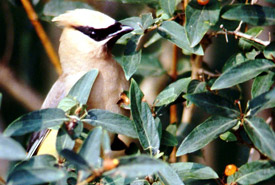
Cedar waxwing (Photo by Glen Maceachern)
Cedar waxwing
Habitat — Prefers a variety of woodlands, particularly along streams, for foraging and nesting. Grasslands and sagebrush also provide habitat. As a fruit specialist, the cedar waxwing won’t visit your bird feeder but back/front yards with berry bushes will certainly attract them.
My recent sightings — Milliken Park. large flocks in Port Credit, Spring Creek Ravine, Allotment Gardens and the Duck Ponds in Toronto's High Park.
Looking for a guarantee?
Naturalized urban areas such as the Leslie Street Spit, a five-kilometre-long peninsula off the Toronto waterfront, often sustain habitat for diverse bird, butterfly and plant communities. Leslie Street Spit's 316 migratory and resident bird species, 50 butterfly species and around 400 plant species give visitors a pretty secure chance at spotting wildlife all year round. A locally rare mutation of the common garter snake, the black eastern garter snake, is found here in healthy numbers and is quite stunning!
Eastern garter snakes will hibernate until early April. Until then it isn't wise to be lifting rocks or disturbing holes where they might be resting. In spring when they become more active, cautiously peering under rock, wood and stick piles might reveal them or their habitats to you.
Why it matters, from a human standpoint
Protecting urban wildlife corridors, like the Don Valley and Humber Valley in Toronto, helps ensure habitat stability and a holistically healthier city. If you’re looking to delve deeper, many cities publish booklets about local urban biodiversity. For example, the City of Toronto released a trusty Biodiversity Booklet Series on the worlds of butterflies, spiders, fish, mammals, reptiles and amphibians found in the city.
If “one touch of nature makes the whole world kin," we independent-minded urbanites could use a touch, or two. In a city like Toronto it is not difficult to see how one could feel apart from nature rather than a part of it. And yet, Toronto is full of ecological communities.
Writers such as Henry David Thoreau, John Muir, E. O. Wilson, along with modern scientists and naturalists, have well documented the wellness and health benefits of exploring nature. Even from within our urban jungle, with a focus on conservation, nothing can stop us from being a part of nature.


